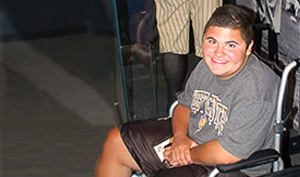Liam: Duchenne Muscular Dystrophy
"The clinicians are always asking how Liam is doing at home, at school, in social situations. They really try to get a complete picture of his health and well-being.”
– Liam's Mom

"I do what everyone else does, but in a different way," says 19-year-old Liam of Lincoln University, Pa. That mentality has fueled Liam, now a college sophomore, to live life to the fullest, despite some daunting challenges.
When Liam was just 4 years old, his parents began noticing that he wasn’t able to keep up with other kids his age. He lagged behind when running, climbing or jumping. They took Liam to his pediatrician, who referred the family to a pediatric neurologist. Additional testing in combination with a DNA test confirmed the diagnosis: Duchenne muscular dystrophy.
Muscular dystrophy is a term that describes a group of inherited diseases in which the muscles that control movement progressively weaken. Duchenne is the most common form of muscular dystrophy and predominantly affects males. Because women are carriers of the gene, Liam’s mother and two older sisters were tested and, thankfully, were determined not to be carriers. In Liam’s case, because there was no family history, the muscular dystrophy occurred as a result of a spontaneous genetic mutation.
Collaborative Care for a Complex Condition
Having been born and raised in Delaware, Liam’s mom knew of the excellent reputation of Nemours Children’s Hospital, Delaware, in Wilmington, Del., and decided that was the best place for her son.
As a designated Muscular Dystrophy Association (MDA) Neuromuscular Program, Nemours Children’s Hospital, Delaware has an MDA representative onsite to help patients and families navigate services, educational resources and equipment needs. A team of Nemours experts — including neurologists, orthopedic surgeons, pulmonologists, respiratory therapists, cardiologists and physical therapists — is ready and available to care specifically for patients like Liam with neuromuscular conditions.
"The clinicians are always asking how Liam is doing at home, at school, in social situations," says Liam’s mom. "They really try to get a complete picture of his health and well-being."
With input from his family, the medical team developed a comprehensive, coordinated plan focused on maximizing Liam’s independence and his quality of life. Liam’s mom is particularly impressed that Mena Scavina, DO, pediatric neurologist and co-director of the Neuromuscular Program, and Alisa Clark, the program’s nurse practitioner, keep her family updated about the latest research and new studies for the treatment of Duchenne muscular dystrophy. "It feels like they are advocating on our behalf," she says.
Adapting Over Time
Despite struggles with coordination and slowed running ability, Liam, a sports and baseball enthusiast, loved playing Little League baseball. Although he had some falls, he remained injury-free until he broke his leg at 8 years old. William Mackenzie, MD, pediatric orthopedic surgeon, chair of the hospital’s orthopedics department and co-director of the Neuromuscular Program, used an external fixator instead of a cast so that Liam could keep walking and continue to be active until the bone healed.
Unfortunately, by the age of 15, the disease had progressed so much that Liam could no longer walk unaided. As the disease continued to progress, the comprehensive care and services Liam needed were all available at Nemours. He received customized orthotics for his legs (to prevent contractures at night), aqua therapy to speed his recovery after his femur fracture, and customized wheelchair seating and mobility.
Onward and Upward
As Liam approaches age 21 and the need to transition care to an adult provider, the Neuromuscular Program team at Nemours Children’s Hospital, Delaware has partnered with ChristianaCare Health System and the University of Delaware’s Center for Disabilities Studies. By allowing time for patients and families like Liam’s to adjust to a new provider, the anxiety and uncertainty can be better managed. Liam has already begun to see Jennifer LeComte, DO , an internist who leads the Transition of Care Program at nearby ChristianaCare.
Today, Liam is a friendly, positive young man who can be found in the dugout of his college’s baseball team, compiling the team’s statistics and rallying them for their next win. You also might find him swimming in his pool or playing video games. As a history major, he’s not sure where his career path will lead — maybe teaching. But regardless, he’s confident that if he follows his passions, it will all work out.


